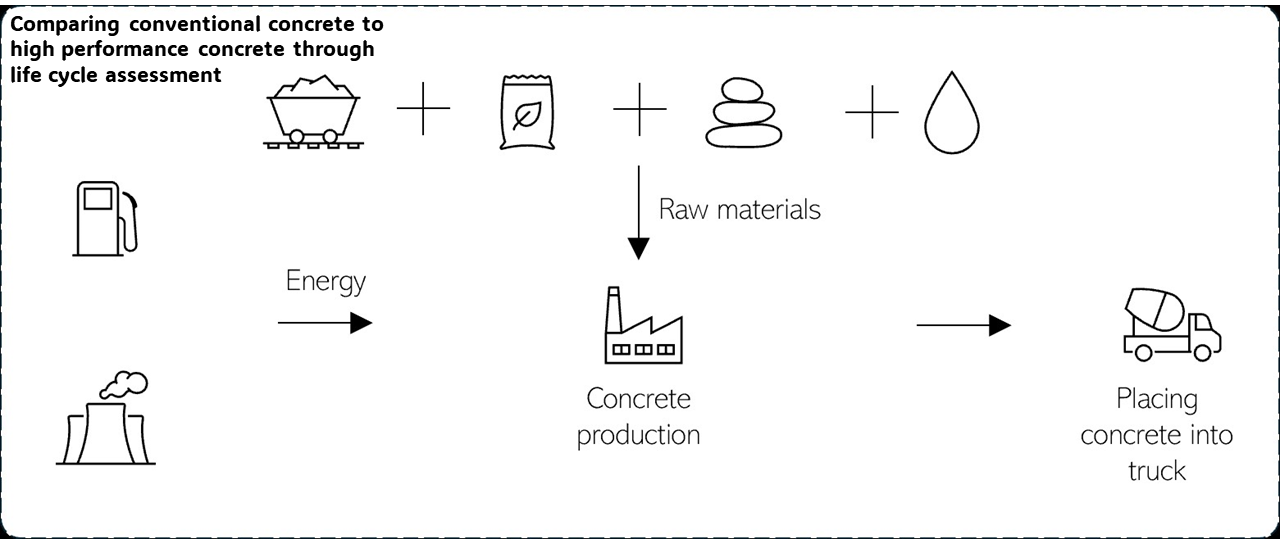Comparing conventional concrete to high performance concrete through life cycle assessment
DOI:
https://doi.org/10.14295/bjs.v3i3.531Keywords:
life cycle assessment, cement-based materials, sustainable constructionAbstract
In this study, conventional concrete is compared to high performance concrete in terms of environmental performance. The Open LCA software along with the Ecoinvent database 3.1 and data from a literature review were used. The ReCiPe life cycle impact assessment methodology was applied. Results show better environmental performance for high performance concrete. Regarding climate change and water depletion results, conventional concrete turned out to have almost twice the impact of high performance concrete, while for the fossil depletion and human toxicity indicators results were even higher. In addition, it must be noted that high performance concrete also results in benefits regarding dematerialization since it is needed 0.654 m3 less than in the conventional concrete case for the same function. Nevertheless, further analysis should be conducted using primary data.
References
Characterisation – ReCiPe. (n.d). (2014). Retrived December 20, 2014. Available in http://www.lcia-recipe.net/characterisation-factors
Fava, J. A. (2006). Will the next 10 years be as productive in advancing life cycle approaches as the last 15 years? The International Journal of Life Cycle Assessment, 11(1), 6-8. https://doi.org/10.1065/lca2006.04.003 DOI: https://doi.org/10.1065/lca2006.04.003
Fiala, C., Novotná, M., & Hájek, P. (2013). Methodology of life-cycle assessment of RC structure using high performance concrete. In: Central Europe towards Sustainable Building, 1-5. https://cesb.cz/cesb13/proceedings/5_tools/CESB13_1433.pdf
Habert, G., Arribe, D., Dehove, T., Espinasse, L., & Le Roy, R. (2012). Reducing environmental impact by increasing the strength of concrete: Quantification of the improvement to concrete bridges. Journal of Cleaner Production, 35, 250-262. https://doi.org/10.1016/j.jclepro.2012.05.028 DOI: https://doi.org/10.1016/j.jclepro.2012.05.028
Häfliger, I. -F., John, V., Passer, A., Lasvaux, S., Hoxha, E., Saade, M. R. M., & Habert, G. (2017). Buildings environmental impacts’ sensivity related to LCA modeling choices of construction materials. Journal of Cleaner Production, 156, 805-816. https://doi.org/10.1016/j.jclepro.2017.04.052 DOI: https://doi.org/10.1016/j.jclepro.2017.04.052
International Organization for Standardization. (2006a). ISO 14040:2006 Environmental management – Life cycle assessment – Principles and framework.
International Organization for Standardization. (2006b). ISO 14044:2006 Environmental management – Life cycle assessment – Requirements and guidelines.
JRC European Commission. (2010). ILCD Handbook: Analysis of existing environmental impact assessment methodologies for use in life assessment. Background document.
Sjunnesson, J. (2005). Life cycle assessment of concrete. Lund University, Department of Technology and Society Environmental and Energy Systems Studies.

Downloads
Published
How to Cite
Issue
Section
License
Copyright (c) 2024 Yazmin Lisbeth Mack-Vergara

This work is licensed under a Creative Commons Attribution 4.0 International License.
Authors who publish with this journal agree to the following terms:
1) Authors retain copyright and grant the journal right of first publication with the work simultaneously licensed under a Creative Commons Attribution License that allows others to share the work with an acknowledgement of the work's authorship and initial publication in this journal.
2) Authors are able to enter into separate, additional contractual arrangements for the non-exclusive distribution of the journal's published version of the work (e.g., post it to an institutional repository or publish it in a book), with an acknowledgement of its initial publication in this journal.
3) Authors are permitted and encouraged to post their work online (e.g., in institutional repositories or on their website) prior to and during the submission process, as it can lead to productive exchanges, as well as earlier and greater citation of published work.




